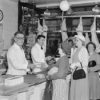Before there were cars… There was the traffic signal.
It was December 1868. And in London England, pedestrians were increasingly terrorized by the growing number… of horse drawn carriages. Imagine giant trampling beasts racing unregulated through intersections, dragging 500-pound carts… and you kinda get the picture.
Enter John Peake Knight. He had designed signals to regulate traffic on Britain’s railroads. So he came up with something similar for street traffic: A tall pole with a little flag. A horizontal flag meant “stop.” And a flag at an angle meant “proceed with caution.” At night, different-colored gas lamps did the same job.
The new signal worked great! Except one design flaw: It had to be operated manually. By a policeman who stood beside it in the cold, all day long. And to add injury to insult? A month after the signals were installed… one of the gas lamps blew up in an officer’s face. Britain quickly scrapped the whole project.
It was 46 years before the first electric traffic lights lit up. This time at an intersection in Cleveland, Ohio. A signal stood at each corner, with a red light and a green light. These were also operated by a policeman… But with two major improvements: The lights didn’t explode… And the officer got to sit in a nice, warm booth.
By the way, since the early days of railroads red has always meant “stop.” But at first, white meant “go.”
That got changed after the red lens fell out of a “stop” signal, exposing the white light behind it. So a conductor disastrously mistook “stop” for “go.” The ultimate crossed signal.
The Morgan-Euclid

Created by Micheal Siao of L’Albatros Brasserie + Bar, this cocktail is named for the intersection (just a few blocks from his bar) where the first traffic light went up.
Ingredients
1 1/4 oz Chartreuse
1 1/4 oz gin
1/2 oz fresh lime juice
Cherry and lemon peel for garnish.
Instructions
Shake the liquid ingredients together and strain into a glass – the mixture will be green from the Chartreuse. Drop a red cherry in the bottom, and add a bright yellow lemon peel at the top. Enjoy responsibly – it won’t make you a better driver.


